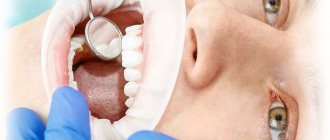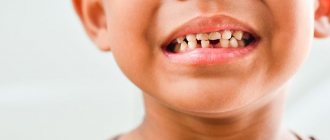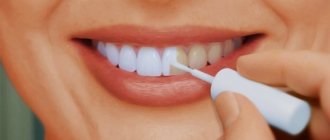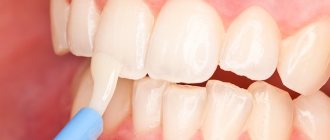Dentistry "Stomus" > Useful tips > Erosion of tooth enamel. Causes and treatment
Erosion of tooth enamel is a common non-carious lesion accompanied by thinning of the enamel and dentin layers. As a rule, this disease is located symmetrically in the oral cavity: on premolars, canines or incisors. As a result of erosion, visible cosmetic defects appear on the teeth. In addition, the problem leads to painful sensations when eating food and drinks, when brushing teeth, cold air, chemical irritants, etc.
If signs of erosion are detected, it is recommended to begin treatment immediately, since lack of treatment aggravates the enamel defect and can lead to complete loss of enamel on the outer surface of the tooth. The surfaces on which erosion develops gradually begin to become pigmented.
Causes of the disease
Doctors have not yet established the exact factors causing this disease, since it can occur in almost any person, but experts have settled on the following options:
- Mechanical. Explains the manifestation of the disease by excessive mechanical stress placed on the teeth. For example, brushing your teeth with an excessively hard brush or using whitening abrasive paste or powder at home too often can scratch the tooth, which will lead to erosion;
- Chemical. Researchers who adhere to this theory cite exposure to foods with high levels of acidity on the enamel as the main causes of dental erosion;
- Endocrine. The concept is based on the results of studies that have found a relationship between erosion and hyperfunction of the thyroid gland. It is known that people suffering from thyrotoxicosis are twice as likely to visit the dentist due to dental erosion;
- Increased load on the dentition, when, with an incorrect bite or the absence of individual units, the chewing function is performed unevenly;
- Some medications can also cause enamel erosion as a side effect;
- In industries with metal or mineral dust, as well as when working with chemicals.
The causes of the disease can be determined more accurately with complex hardware diagnostics.
Medical Internet conferences
Introduction. Currently, dental erosion occupies a significant place among diseases of hard dental tissues. There are many opinions about the origin of erosive defects, and this issue has not been fully studied. This topic gives rise to a lot of controversy and questions among scientists and doctors, and therefore requires more attention. Research results indicate a significant increase in the prevalence of dental erosion in the last 10 years. Thus, when examining a population group, 47.2% of people with dental erosion were identified, while 10-15 years ago there were no more than 5-7% of such patients. When analyzing the frequency of non-carious dental lesions, based on patients’ visits to the dental clinic, 29.5% of people with dental erosion were identified. Meanwhile, 10-15 years ago there were only 24 such patients. Moreover, the disease was observed mainly in women (84.9%) aged 25-30 years. The combination of erosions with hormonal disorders (including dysfunction of the thyroid and gonads) accounted for more than 75% of cases.
Objective: to analyze literature data on the etiology of erosive defects and their impact on the quality of life of patients.
Tasks:
1) characterize the hypotheses of the origin of erosions of hard dental tissues
2) to study the mechanism of occurrence of erosions of enamel and dentin
3) assess the quality of life of patients with erosive dental defects
4) create a draft treatment plan for patients suffering from erosive dental changes.
Materials and methods: scientific articles and works, domestic and foreign scientific literature on dentistry were analyzed, clinical cases of erosion of hard dental tissues of varying severity of the pathological process were analyzed.
Results and discussions. Hard tissue erosion (erosion) (from the Latin erosio - “corrosion”) is the progressive loss of tooth enamel and dentin. In foreign literature, both narrow terms are used: “attrition”, “abrasion”, “erosion”, “abfraction”, and broader ones: “toothwear” and “tooth surface loss”. In European literature, the most common point of view is that erosion is a more important factor in the loss of hard dental tissues than abrasion due to contact of tooth surfaces. Occurs after teething. The affected area can be located on the vestibular and palatal surfaces and has a round, cup-shaped shape with dense, smooth, flat edges. This is a differential diagnostic feature when making a diagnosis. The upper incisors are primarily affected, less commonly the canines and premolars. It is extremely rare that erosions occur on the teeth of the lower jaw. Probing and percussion are painless. EDI 2-4 µA. The oral mucosa is without visible pathological changes.
2. The causes of erosion have not been clearly established.
According to ICD-10, the pathological condition of hard dental tissues is divided into two large groups:
· “Disorders of development and teething”
· “Other diseases of dental hard tissues.” K03
Tooth erosion refers to diseases of the hard tissues of teeth. K03.2
K03.2 Tooth erosion:
K03.20 Professional;
K03.21 Caused by persistent regurgitation or vomiting;
K03.22 Due to diet;
K03.23 Caused by drugs and medications;
K03.24 Idiopathic;
K03.28 Other specified dental erosion;
K03.29 Dental erosion, unspecified.
The first four causal factors of this classification reflect the chemical theory of the development of dental erosion present in the medical literature of previous years, which in turn considers the impact of aggressive chemical agents on the enamel as the leading causes:
I. External factors:
1) type of diet: consumption of acid-containing foods and drinks (marinades, pickles, citrus fruits, fruit and berry juices, sweet carbonated drinks, etc.)
2)work in hazardous industries associated with inhalation of acid fumes, metal and mineral dust particles
3) The effect of a number of medications on tooth enamel, for example, acid (acetylsalicylic and ascorbic), gastric juice preparations, hydrochloric acid.
II. Internal factors:
4) Dental erosion can be caused by chemically aggressive contents of the stomach and duodenum with a low pH content in chronic gastroesophageal regurgitation that occurs with gastroesophageal reflux disease, as well as with combined duodeno-gastroesophageal reflux disease. Erosive lesions are observed in individuals with hiatal and diaphragmatic hernias and those suffering from bulimia.
Damage from internal factors usually occurs on the palatal surfaces, and from external factors - on the buccal surfaces.
D. A. Entin saw the cause of erosion in neurodystrophic processes that cause decalcification of hard tooth tissues. However, no one can explain why erosions occur in some cases and wedge-shaped defects in others. Their occurrence may be associated with a violation of mineral metabolism due to endocrine or other disorders in the body and, accordingly, in the dental pulp. This is confirmed by the results of clinical observations and data from radioimmunological studies, which indicate the presence of clear preceding and concomitant dysfunctions of the thyroid gland in patients with erosions of dental enamel. Thus, Yu. M. Maksimovsky et al., analyzing the causes of erosions, assign an important role to endocrine disorders and, above all, hyperfunction of the thyroid gland. It was noted that dental erosions in patients with thyrotoxicosis were detected 2 times more often than in persons with normal thyroid function; a direct connection was established between the intensity of dental damage and the duration of thyrotoxicosis. As the duration of the disease increases by 1 year, the number of patients with erosion of hard dental tissues increases by 20%.
Dr. Kim McFarland, a dental surgeon and professor at the College of Dentistry at the University of Nebraska Medical School in Lincoln, USA, notes an increase in the number of patients with erosion of tooth enamel over the past 25 years, which is associated with uncontrolled consumption of carbonated sugary drinks.
A number of researchers (Baume, Port and Eidler) associate tooth erosion with excessive mechanical stress on the enamel, namely the use of hard toothbrushes, whitening toothpastes and powders with increased abrasiveness, as well as improper brushing techniques - a predominance of horizontal movements.
The combination of several predisposing factors accelerates the course of erosion and aggravates its severity. For example, drinking large amounts of very low pH drinks causes tooth surface loss when combined with brushing immediately after an acid attack on the teeth.
Yu. M. Maksimovsky details the clinical manifestations of erosions and distinguishes three degrees of damage, based on the depth of the hard tissue defect:
I degree (superficial, initial) – with damage to only the upper layer of enamel
II degree (medium) – with damage to the enamel throughout the entire depth up to the enamel-dentin border.
III degree (deep) – with damage to the entire enamel and the upper layer of dentin.
E.V. Borovsky et al., distinguish two stages of damage: initial (enamel erosion) and severe (enamel and dentin erosion).
In degrees 1 and 2, the lesion is white with a shiny surface; in degrees 3, brown or light yellow pigmentation appears.
Dental erosion is usually characterized by a chronic course, but there are two clinical stages of erosion: active and stabilized.
The active stage is characterized by a progressive course and loss of tooth tissue, accompanied by hyperesthesia and the disappearance of the shine of the erosion surface. In the active phase, changes in the size of erosion occur every 1.5-2 months.
The stabilized form of erosion of hard tooth tissues is characterized by a calmer, slower course, and the shiny surface of the enamel in the affected area is preserved. There is no change in its size for 9-11 months. A transition from a stabilized form of erosion to an active one is possible, especially if the background pathology worsens.
3. Pathogenesis
Unlike dental caries, where there is superficial, subsurface demineralization of the enamel, during erosion, superficial foci of demineralization are formed, which gradually cover the tooth enamel layer by layer. The microhardness of the enamel in the area of erosion is significantly reduced, and foci of demineralization of the enamel surface are noted. When studying the ultrastructure of enamel during tooth erosion using a scanogram, it was noted that the enamel in the area of erosion and in adjacent areas is characterized by a reduced degree of mineralization and the presence of destructive changes: in some areas, enamel prisms are clearly visible, interprismatic spaces are pronounced, and in others, enamel prisms and interprismatic spaces indistinguishable due to demineralization. Hydroxyapatite crystals of various shapes. In areas adjacent to erosion, they do not have clear boundaries or have a regular shape, but are large. Crystals of enamel hydroxyapatite with varying densities are visible on the surface of the enamel, indicating uneven mineralization. There are also distinct changes in dentin during tooth erosion: areas with a dense arrangement of crystals are observed. Dentinal tubules can be obliterated or non-obliterated. The structure of the substance that obliterates the dentinal tubules is specific and close to that during abrasion, however, along with the indicated areas of demineralization, accumulations of bacteria were found that mask the contours of the enamel prisms.
Comparative electron microscopy (SEM) of the central erosion zone also showed the presence of significant structural changes in both the superficial and deeper layers of damaged dental tissue. The active stage of the process is characterized by the loss of both enamel substance and dentin in large areas that have undergone destructive changes.
In the cervical region of teeth with erosive defects, an intermittent but quite clearly visible boundary between the crown and root is visible. In all studied cases, the crown enamel was layered on the root cement.
4.Quality of life of patients with dental erosion.
Enamel is the protective shell of the tooth. The process of enamel erosion is irreversible and creates problems for a person for life.
Patients complain of an aesthetic defect, the presence of a defect in the cervical area, tooth sensitivity, and tissue loss.
According to our data (based on the number of visits to the clinic), about 15% of patients are aged 16-42 years.
We observed 3 patients with varying degrees of dental erosion.
1) Patient A., 23 years old; preliminary diagnosis: dental erosion, stabilized form; mild severity according to ICD-10 K03.2. Complaints about dissatisfaction with the color of teeth. Objectively: on the vestibular surface in the cervical area of 1.1 and 2.1 teeth there is a defect affecting only the upper layer of enamel, the oral cavity is sanitized, the oral mucosa is without pathological changes, IG - 1.7 (satisfactory).
History: consumption of freshly squeezed citrus juices, professional cleaning with Air-flow 2 times, tried to use whitening toothpastes.
2) Patient K., 28 years old; preliminary diagnosis: active stage of dental erosion, moderate to severe degree according to ICD-10 K03.22
Complaints about tooth sensitivity, aesthetic defects, yellow teeth.
Objectively: on the vestibular surface in the cervical region, 1.1 teeth have a pronounced defect within the enamel and 2.1 teeth have affected the entire enamel and the upper layer of dentin. The oral cavity is sanitized, the oral mucosa is without pathological changes IG-2.2 (unsatisfactory).
History: consumption of citrus fruits, incorrect selection of oral hygiene products and items, incorrect method of brushing teeth with a predominance of horizontal movements.
3) Patient L., 42 years old; preliminary diagnosis: active form of dental erosion, severe degree according to ICD-10 K03.21
Complaints about the presence of defects in the cervical area, tooth sensitivity and aesthetic defects.
Objectively: erosive defects in the frontal group of teeth of the upper and lower jaw, in the cervical area there are lesions of brown pigmentation. The oral cavity is sanitized, the oral mucosa is without pathological changes, IG-1.6 (satisfactory)
History: occupational hazards, chronic gastroesophageal regurgitation, traumatic occlusion, crowded teeth.
Thus, regardless of the severity of erosion, the quality of life of these patients suffers to one degree or another. Even if practically nothing bothers the patient at first, in the future, in the absence of correction of etiological factors and specialist interventions, the symptoms increase like an avalanche (according to patients with more pronounced defects), which forced us to try to create an algorithm for treatment and preventive measures (draft treatment plan) for this group patients.
5. RECOMMENDATIONS
Enamel erosion is not just an external problem, but a serious disease, and therefore the attitude towards treatment is no less serious.
- A thorough ascertainment of the patient’s history and current condition with the involvement of related specialists (therapist, gastroenterologist, endocrinologist, pediatrician, etc.), gastronomic preferences, and features of professional activity will significantly identify the possibility of correcting patient-dependent factors or, at a minimum, recording them in the outpatient dental record. sick.
- Treatment of patients with erosion should be comprehensive and long-term.
- Strict diet (except citrus fruits, berries, sweets, carbonated drinks, fresh juices containing vitamin C, canned foods). Include protein in your diet to strengthen the protein matrix of enamel and collagen fibers.
- Select products (pastes containing organic calcium, with hydroxyapatite) and hygiene items (correction of the rigidity and structure of the brush bristles, excluding the use of toothpicks), as well as teach the correct method of brushing teeth (vertical movements).
- Remineralizing therapy (Rocs medical minerals gel, Remars gel, Clinpro™ White Varnish,) Tooth Mousse, “Belagel Sa/R” “VladMiVa”) in a clinical setting in the form of applications and mouth guards (preferably individually). At home daily, perhaps constantly, but necessarily regularly, depending on the degree - office-based in combination with fluoride applications to prevent concomitant caries and to strengthen the crystal lattice of hydroxyapatite.
- Avoid ultrasonic teeth cleaning, home and professional whitening, and Air-Flow teeth cleaning.
- For professional hygiene, use pastes with minimal abrasiveness “fine”.
- Restoration if necessary, after complex treatment. It is possible to use the Icon technique, as well as the use of a desensitizer (SHIELD FORCE PLUS).
- clinical examination with photographic recording of the result.
Conclusions:
1. In the etiology of erosion of hard dental tissues, the following factors interact: exogenous (occupational hazards, dietary habits) and endogenous factors (metabolic disorders, endocrinopathies, bruxism, diseases of the gastrointestinal tract) in combination with improper oral care.
2.The main mechanism is demineralization of the enamel.
3. Regardless of the severity of erosion, the quality of life of these patients suffers to one degree or another. Even if at first there is practically nothing bothering the patient, in the future, in the absence of correction of etiological factors and specialist interventions, the symptoms increase like an avalanche.
4. The algorithm of treatment and preventive measures for this group of patients should include:
-correction of both external and internal etiological factors;
-specialized treatment by a dentist before the required restoration with the use of remineralizing and fluoride-containing drugs up to restoration (using filling materials from the group of compomers or GIC);
- general treatment with mandatory medical examination for a long time (lifelong).
Stages of tooth enamel erosion
There are three stages of tooth enamel erosion:
- Initial. This stage is very difficult to notice yourself. Usually, at the initial stage, the dentist notices erosion, since only in some areas of the tooth the enamel loses its shine and changes shade;
- Average. Teeth begin to react to cold, hot, salty and sweet, pigmentation becomes visually noticeable;
- Deep. The enamel is almost completely destroyed, with yellow and brown pigmentation.
There are 2 forms of dental erosion. The active form is characterized by a rapid course of the disease, changes in the structure and color of the enamel. The stable form is practically asymptomatic, since in this case the body itself produces dentin to protect the affected areas of the enamel.
Causes of erosion and consequences of pathology
Erosion of tooth enamel is a type of non-carious lesion. The first signs of the disease are the appearance of small, slightly protruding areas on the surface of the teeth; the course at the initial stage is without obvious symptoms. However, over time, the enamel’s sensitivity to temperature factors increases, the spots gradually darken, unpleasant and even painful sensations appear, and hard tissues begin to wear out very quickly.
Important! At the moment, the reasons for the development of pathology are not precisely known!
However, experts name a number of factors that can provoke the appearance of erosion. Among them:
- disturbances in the functioning of the endocrine system;
- causing mechanical damage (including the use of home methods for whitening tooth enamel, hygiene with a hard brush, abuse (constant use) of dental veneers with abrasive particles, etc.)
- exposure to certain chemicals (eg, vinegar, sour drinks, citrus fruits);
- uneven chewing load (standard reasons - malocclusion, loss of a unit of dentition without timely restoration);
- constant interaction with chemicals, contact with mineral or metal dust (usually associated with professional activities).
- long-term use of potent pharmaceutical drugs.
By delaying contacting the dentist, you risk waiting until the damaged top layer leads to dentin damage.
Treatment methods
- Therapeutic. Vitamin complexes with fluoride and calcium are prescribed;
- Polishing and strengthening with special pastes with medicinal compounds to strengthen the enamel;
- Remineralization. Every day, teeth are covered with pastes containing calcium, fluorine, phosphorus, zinc and other components that heal the enamel;
- Electrophoresis. A procedure that saturates teeth with nutrients;
- Filling. Some enamel defects can be closed with filling materials
- In case of serious irreversible damage, the lack of hard tissue is compensated by veneers, artificial crowns and composite materials.
The main thing when this problem is detected is not to self-medicate and fight erosion with traditional medicine. Because in this case, you can only aggravate the situation, and it is impossible to stop the thinning of the enamel using such means.
Why you can't ignore the problem
If the problem is not recognized in time and treatment is not started, very serious complications are possible, namely:
- distribution of dark spots over the entire surface of the tooth;
- violation of the uniformity of enamel color (up to the transparency of the cutting edge);
- increased abrasion of enamel, accelerated wear of teeth;
- increased sensitivity to temperature influences, the appearance of painful sensations.
When the lesion spreads to the dentin, rapid destruction of the hard tissues of the tooth occurs, as a result - the development of various dental diseases
The widest risk group by age is people of middle age, but the pathology is often found in children.
Prevention treatment
- brushing teeth twice a day;
- using toothbrushes with natural bristles, soft or medium hard;
- using high-quality toothpastes with high fluoride content to strengthen and mineralize enamel;
- reducing the amount of foods containing aggressive acids in the diet;
- end meals with foods with neutralizing properties (hard cheese, milk, etc.).
Your teeth need constant care and attention. Only preventing their diseases will help maintain their healthy appearance. To do this, you need to visit the dentist once every six months for examination and professional hygiene.
Diagnostics
This disease can be diagnosed during a dental examination. The dentist detects the location of the erosive focus by thoroughly drying the tooth surface with a stream of air and lubricating it with 5% iodine tincture. The area of enamel affected by the disease becomes brownish in color.
Erosion differs from other pathological processes in its contours, localization, smooth surface and is usually located closer to the base of the root.
The earlier the pathology is diagnosed, the more successful its treatment will be.
Destruction of tooth enamel
Necrosis of tooth tissue
- this is a non-carious destruction of the structure of the enamel and dentin of teeth due to the influence of negative endogenous and exogenous factors, it is considered a very difficult and serious illness, which often ends in a serious deterioration or even loss of chewing function. It should be noted that it has become more common in recent years than 10-15 years ago.
Let's take a look at the most common forms of necrosis of hard dental tissues.
Chemical (acid) necrosis
It can develop as a result of exposure to various acids (acidic products) on dentin and enamel. Tooth decay can go unnoticed, since the enamel is not damaged in the early stages. This happens either as a result of a negative production factor (which is a high concentration of acids and various other substances within the workplace), or due to frequent or constant exposure to acid-containing products, medications, and drinking. The enamel softens and gradually breaks down, exposing dentin, which is a fairly soft tissue.
Getting carried away with drinks like Coca-Cola increases the prevalence of this pathology and complete tooth destruction. Further, pain may occur when exposed to temperature and chemical stimuli. As dentin loses enamel, it becomes dark.
Its treatment depends on the degree of manifestation of chemical necrosis of teeth. When teeth are completely destroyed, implantation is performed. Thus, the scope of therapeutic measures in the initial forms can be limited to stopping or maximally reducing the effect of chemical reagents on the teeth, as well as when carrying out complex remineralizing therapy for a period of 3 to 6 months. Our clinic has developed effective schemes for both treatment and prevention of this pathology.
Computer necrosis of teeth
In recent years, dentists have encountered a completely new and completely unexpected, as well as practically unstudied pathological process in teeth, which is characterized by systemic damage. It is more intense than from radiation therapy.
It is most often observed in young and middle-aged people who have been working with computers of different models for more than five years, in combination with non-compliance with the work schedule, professional protection, and occupational hygiene. Often, the side of the jaws facing the monitor is affected more intensely. The main foci of necrosis can cover both a significant and most of the crowns of the teeth. The lesions are characterized by pigmentation and painlessness, as well as tooth decay.
Is it possible to avoid these defeats?
It is recommended to follow certain standards when working with a PC:
- A workplace area of less than 6 m2 when the volume of the entire room is from 20 to 24 m2 is unacceptable;
- The location of natural light is on the left;
- If there are 2 computers (or more) in the workroom, then the distance between video monitors should be 2 meters or more (if they are directed in the same direction);
- Users should be at a distance of 0.6 to 0.7 m from the screen;
- After 2 hours of work, you should take a 15-minute break and ventilate the room;
- The total duration of computer use should not exceed 6 hours (for adults), and for children and adolescents - 1-2 hours. For women during pregnancy, using a computer is extremely undesirable in order to avoid tooth decay.
If the disease manifests itself, treatment is carried out in accordance with the clinical situation. At the initial stages of the pathology (when the integrity of the enamel is not compromised), deep fluoridation using APF gel is prescribed. In later stages of the lesion, restoration of the shape of the teeth using artistic restoration or orthopedic structures is used. Implantation in case of complete destruction is also practiced. It would not be superfluous to conduct an examination of the whole body.
Where can you find a qualified dentist in Ivanteevka?
High-quality dental care is provided by specialists from the Sanident clinic. We are one of the largest clinics providing our services in Shchelkovo and in the urban district of Ivanteevka. We have the most modern equipment, employ only professionals with extensive experience, who use progressive methods of dental treatment and provide competent advice. We regularly hold various promotions and discounts for our patients.
The activities of our clinic are aimed at creating maximum comfort for our patients, minimizing pain and discomfort. You can make an appointment with a specialist by calling the number listed on the official website of dentistry.
You can receive the necessary dental services at the following addresses:
- Ivanteevka, st. Novoselki, 4;
- Shchelkovo, st. Central, no. 80.
Bruxism in adults
Bruxism
is a disease characterized by involuntary, periodic and very strong (spastic) contraction of the masticatory muscles, as a result of which the jaws are clenched to the point of grinding the teeth. Typically, attacks of bruxism last a few seconds, but sometimes it can last much longer - several minutes. At the same time, the pulse may increase, blood pressure may rise, and the respiratory rhythm may become disrupted.
Bruxism can appear in a person at any time in life. According to scientists, bruxism occurs in 15% of adults and approximately 50% of children (childhood bruxism). However, not every person knows about his illness, since it manifests itself at night. Most often, family members and relatives tell him about this.
Scientists have not yet fully determined the causes of bruxism, which significantly affects the prevention of this disease. There is an opinion that the causes of its occurrence may be somnambulism, severe snoring, and nightmares. This disease usually affects people with pathologies of the facial skeleton and temporomandibular joint. They say that bruxism most often occurs in a person whose life is full of stress and great emotional stress.
The danger of bruxism is that it can:
- provoke increased tooth wear;
- cause loosening and damage to teeth;
- disrupt the correct bite;
- increase tooth sensitivity;
- develop pathology of the temporomandibular joint;
- cause headache;
- cause pain in the facial muscles.
In addition, the consequences of this disease can be various mental disorders, since the patient feels discomfort in communicating with other people.
Types of disease
There are two types of bruxism: daytime and nighttime. Daytime bruxism is characterized by the habit of intensively clenching the jaws at a time of strong emotional stress, which causes teeth grinding. With night bruxism, a person clenches his jaw tightly and grinds his teeth while sleeping. Several attacks can occur in one night. Most patients suffer from this type of bruxism.
You should not worry if attacks of this disease do not last long (about ten seconds) and are repeated irregularly. Overcoming this disease on your own will not be successful. As soon as a person realizes that he is suffering from bruxism, he should immediately consult a doctor for advice and begin timely treatment.
Treatment of bruxism
Correct treatment consists of identifying the cause and eliminating it. Since the nature of the disease is not completely clear, bruxism is treated by a general practitioner, a neurologist and a dentist. People visit the dentist most often because of symptoms that arise in the maxillofacial area.
How can a dentist help in this situation? Make special silicone mouthguards that are worn at night and significantly soften the load on the dental system. The specialist will also eliminate diseases of the temporomandibular joints, restore defects in the dentition with orthopedic structures, and sanitize the oral cavity.











